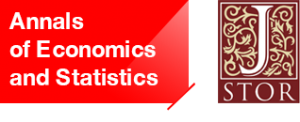Instructions for Submitting Articles to AES
This page describes the instructions for submitting papers to AES.
Key Instructions: Papers should be submitted in PDF format. They should be easily readable and should be under 45 pages. Authors should report in a cover letter any relevant relationships between their submission and other work by the same author currently under review at other journals or reviewed earlier at AES. Submission implies that the work is original, unpublished and not under review elsewhere. Authors are encouraged to supply data sets, programs and other material necessary to replicate results reported in the submission.
Further submission instructions:
- FORMAT
Papers should submitted electronically in PDF format via the Editorial Express platform. It is recommended, though not required at this stage, that authors use LaTex.
Papers should be formatted to be easily readable and should preferably be under 45 pages.
Submitted manuscripts should be formatted for paper of standard size with (i) preferably no more than 45 pages including title page, references and appendices, (ii) margins of at least 1.25 inch on all sides, (iii) 1-1/2 spaced text in 12 point font, (iv) no more than 32 lines per page, (v) preferably no more than 17,000 words. Material should be organized to maximize readability, for example footnotes, figures, etc., should not be placed at the end. The 12pt font and spacing apply to the entire manuscript, including references, appendices.
Authors may include into the submission an appendix intended for online publication only. Such an appendix should be clearly labeled (“Online Appendix’’). Online appendices are for additional results and robustness analyses that are not central to the main paper. They are not for proofs of the key results. It is important that the main paper should be self-contained.
Pages should be numbered, and an abstract (of no more than 150 words with no mathematical expressions), as well as keywords, JEL codes, and complete author affiliations, should be included in the paper in the title page.
- COVER LETTER
A letter of submission could be included if it contains information pertinent to the review process. If the author has submitted related work elsewhere, or does so during the term in which AES is considering the manuscript, then it is the author’s responsibility to provide AES with details. If the submission is on a topic related to earlier rejected submission to AES, the author should describe the relation and explain why he/she believes it is sufficiently distinct to merit independent review.
- PRIOR PUBLICATION POLICY
If an author has submitted or published related work elsewhere, or does so during the term in which AES is considering the manuscript, then it is the author’s responsibility to provide AES with details. This notification must include appearances in Proceedings volumes. The determination of what constitutes previous publication is difficult and takes into account many features and this will be decided on a case-by-case basis. But authors must note all cases of publication other than in working paper series or on personal or university websites.
- REPLICATION POLICY
AES has the policy that all empirical, experimental and simulation results should be replicable. Therefore, authors of accepted papers are encouraged to share the submit data sets, programs, and information on empirical analysis, experiments and simulations that are needed for replication and some limited sensitivity analysis.
This material will not be made available through the AES website but the authors should keep it available if a reader requests it.
At the same time the editors understand that there may be some practical difficulties, such as in the case of proprietary datasets with limited access as well as public use data sets that require consent forms to be signed before use. In these cases detailed data description and the programs used to generate the estimation data sets could be provided, as well as information of the source of the data so that researchers who do obtain access may be able to replicate the results. We also understand that in some particularly complicated cases programs may have value in themselves and the authors may not make them public.
- EXPERIMENTAL PAPERS
Information about experimental procedures is relevant to the decision of whether or not to publish a paper reporting results from laboratory and field experiments and researcher conducted surveys. Detailed information of this type is also valuable to scholars who subsequently do related work or attempt to replicate results.
Important procedural aspects should be explained at the submission stage (either in the body of the paper or an appendix as is appropriate for the particular paper and aspects). We leave the decision on what details to initially include to the author. If during the review process the editor or referees feel additional information is needed, requests for that material will be made, and may naturally cause delay in processing, hence we encourage as complete a submission as feasible.
If any accompanying materials, such as experimental instructions, are not written in English, then a translation should be provided.
- SUPPLEMENTARY MATERIAL
In addition to regularly published material in the journal, AES does not provide a website of supplementary material and they are not encouraged as self contained papers are easier to read. Supplementary material, if any, should be handled directly by the authors.
- FEES
There is no submission fees.
